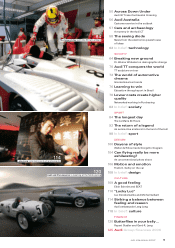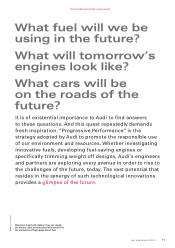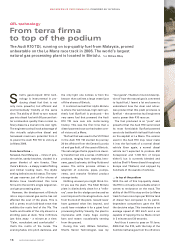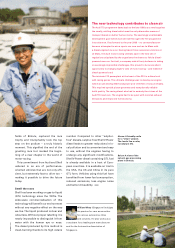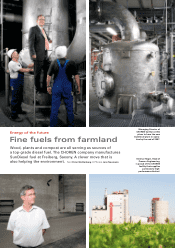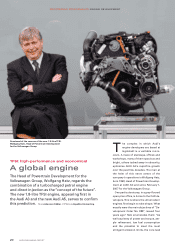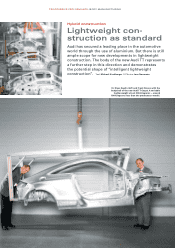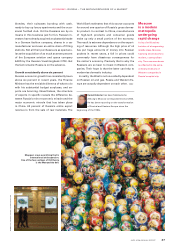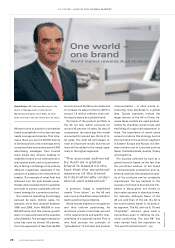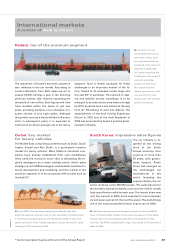Audi 2006 Annual Report Download - page 21
Download and view the complete annual report
Please find page 21 of the 2006 Audi annual report below. You can navigate through the pages in the report by either clicking on the pages listed below, or by using the keyword search tool below to find specific information within the annual report.
Peter Weißenberg, 41, is Head of
the Business and Consumer Sec-
tion and Deputy Editor-in-Chief of
the Sächsische Zeitung newspaper.
Born in Wuppertal, h
e has also written several
books on business and the stock market.
PROGRESSIVE PERFORMANCE: SUNDIESEL FUEL
ILLUSTRATION: CHOREN
19AUDI 2006 ANNUAL REPORT
D
ietmar Rüger would love to tell
his family about his “day at the
office” when he gets home at the
end of a long day. After all, the 46-year-
old is rather proud of what he does. “But
my daughter isn’t really interested,” says
Rüger, shrugging his shoulders. Well,
how many twelve-year-old girls really
want to hear about synthesis gases made
from carbon monoxide and hydrogen?
Perhaps the Head of Process Engineer-
ing at the CHOREN company should
adopt the following approach: “I’m turn-
ing German farmers into the oil sheikhs
of the future.” Even a teenager might
find that almost as exciting as being able
to declare: “My dad’s a horse whisperer!”
In the eyes of engine or fuel developers
and the prime movers of environmental
or economic policies everywhere from
China to California, Rüger’s work ap-
pears even more exciting. They are al-
most queuing up, safety helmet in hand,
to view CHOREN’s football-pitch-sized
construction site in the foothills of the
Ore Mountains. That is where, on the
edge of the small town of Freiberg, spe-
cialists such as the wiry Saxon are build-
ing a chemical plant that could help to
solve the energy problems of the future –
and reconcile economics with ecology:
Rüger and his colleagues are making
one of the cleanest fuels in the world
out of wood, green waste and compost:
SunDiesel.
Even the name of Rüger’s employer,
CHOREN, hints at its agenda: C for carbon,
H for hydrogen, O for oxygen and REN for
renewable. The latter is the main objec-
tive of this pioneering company, in which
the petrochemicals giant Shell holds a
stake of around 25 percent. “We want to
recreate the natural cycle at our plant,”
explains management expert Carlhans
Uhle, one of the three directors, as he sur-
v
eys the gently rolling hills dotted with
forests and fields as far as the eye can
see. These are CHOREN’s green oilfields.
Plants use the sun’s energy to grow,
then decompose into energy sources
such as coal, natural gas or, as illustrated
in this specific instance, oil. A process
that normally takes 400 million years.
The Freiberg company has recreated in
a patented process what otherwise takes
eons – stumps, sticks, flowers and fruits,
branches and trunks are all transformed
into precious diesel fuel in 20 minutes.
Fully biodegradable
“Our first economically operating plant
will be completed here by the end of
2007,” explains 48-year-old Uhle, sur-
rounded by 20-metre-high steel scaffold-
ing; they will soon be supporting a com-
plex pipework structure that will cool
down the gases from the biomass and
transform them into the precious fuel.
At the rate of 16,000 tonnes a year. A
test facility just alongside it has already
delivered incontrovertible proof that
CHOREN’s “magic” process for making
diesel fuel genuinely works.
Particularly importantly for Uhle,
“SunDiesel isn’t just any old biofuel.” It
delivers much more energy – and does
not do any more damage to the global
climate than plants such as the gera-
niums on Uhle’s balcony. It is not even a
particular problem if residues from the
liquid seep into the ground. “That’s be-
cause our fuel is entirely biodegradable,”
beams the financial expert Uhle. Every
user of conventional diesel will more-
over appreciate the fact that SunDiesel
is crystal clear and entirely odourless.
In 2009 CHOREN will be building its
first plant of an economically optimal
scale: it has a designed annual capacity
of 200,000 tonnes of SunDiesel. “It will
need a catchment area of around 30 kilo-
metres, with forests and farmland,” adds
Uhle. The pioneering company already
owns a suitable site in Mecklenburg-
Western Pomerania. But at present,
managers and politicians from all over
the world are clamouring to attract this
reference facility to their own region. His
expert, Rüger, is currently in the process
of training new chemists and machine
operators, and amid a forest of steel
tanks the size of a small car, with fire-
red cladding the thickness of a person’s
arm, explaining precisely how the top-
secret plant is operated. That is one of
the key reasons why the Volkswagen
Group, another of CHOREN’s backers,
would prefer it to be sited in Germany.
But the SunDiesel idea can in principle
be applied wherever there is vegetation.
It seems almost paradoxical at a time
when oil and gas are in short supply, but
CHOREN’s specialists perceive ample
potential for raw materials. By as early
as 2025, as much as a quarter of all
diesel fuel used in Germany could be
produced domestically.
Dietmar Rüger is not the only one to be
convinced that a network of SunDiesel
plants will be supplying fuel to German
car drivers within as little as a decade. By
then, even his daughter might realise
how proud she can be of her father –
every time she calls in at the filling
station.
400 million years in 20 minutes
How CHOREN makes diesel from wood, compost and plants
2
1
3
of carbon dioxide are still
present. This gas is then further
processed.
CHOREN uses the subsequent
Fischer-Tropsch process to
convert the purified synthesis
gas into the biofuel SunDiesel.
3
fier operating at temperatures
of up to 1,600 degrees Celsius.
The organic compounds are
unable to withstand such high
temperatures, which produce a
synthesis gas (carbon monoxide
and hydrogen) in which traces
2
Carbo-V process: the stored
biomass is first converted
into solid carbon and gas
containing tar in a gasifier at
around 500 degrees Celsius.
These products are passed
separately into a second gasi-
1


